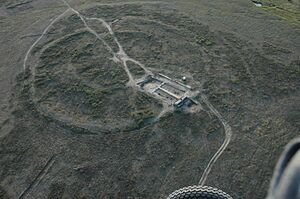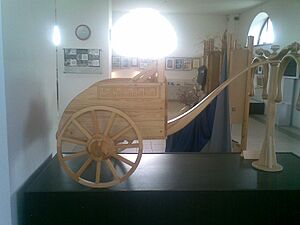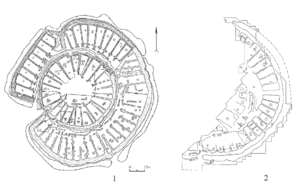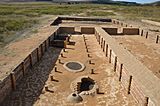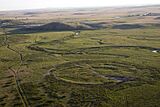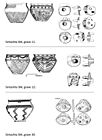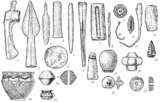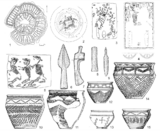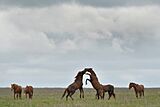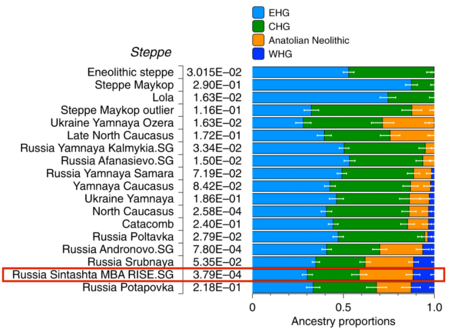Sintashta culture facts for kids
The Sintashta culture was an important group of people who lived in the Southern Urals region around 2200 to 1900 BCE. This time is known as the Middle Bronze Age. The culture is named after the Sintashta archaeological site in Russia. It spread across parts of Russia and Northern Kazakhstan.
Many experts believe the Sintashta culture is where the Indo-Iranian languages began. These languages were spoken by people who called themselves the Aryans. It's thought that the Sintashta people moved eastward from an earlier group called the Corded Ware culture.
The Sintashta culture is famous for having the earliest known chariots. These chariots were found in their burial sites. This technology then spread across the Old World and changed ancient warfare. Sintashta settlements were also very good at copper mining and making bronze. This was unusual for people living on the steppe (large grasslands). Their settlements were often fortified (like small forts), and they were known for being very military-focused.
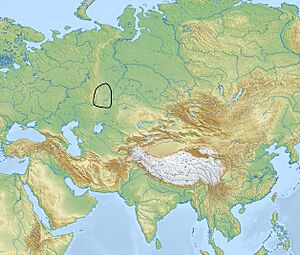 |
|
| Period | Late Middle Bronze Age |
|---|---|
| Dates | 2200–1900 BCE |
| Type site | Sintashta |
| Major sites | Sintashta Arkaim Petrovka |
| Characteristics | Extensive copper and bronze metallurgy Fortified settlements Elaborate weapon burials Earliest known chariots |
| Preceded by | Corded Ware culture Poltavka culture Abashevo culture Fatyanovo–Balanovo culture |
| Followed by | Andronovo culture, Srubnaya culture, Sauromatians |
Contents
How the Sintashta Culture Began
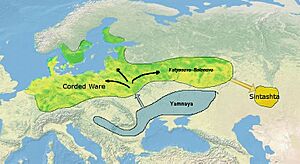
It was hard to find Sintashta sites at first because later settlements were built on top of them. In the 1990s, experts finally realized it was a separate culture from the Andronovo culture.
Some archaeologists think the Sintashta culture grew from two earlier groups: the Poltavka culture and the Abashevo culture. However, genetic studies suggest that the Sintashta people might have moved east from the Corded Ware culture. Other studies also hint that the Sintashta people were a mix of ancient hunter-gatherers and steppe herders.
The Sintashta culture appeared during a time when the weather was changing. The Kazakh steppe, which was already dry, became even colder and drier. This made the wet lowlands near the Ural and Tobol rivers very important for survival. Because of these tough conditions, herders from the Poltavka and Abashevo cultures started to settle permanently in river valleys.
The Poltavka culture was an earlier group in the Ural-Tobol steppe. They were cattle herders. Many Sintashta towns were built on top of or near older Poltavka settlements. Also, Sintashta pottery often had designs similar to Poltavka pottery.
The Sintashta culture also shows influences from the late Abashevo culture. This group came from the Fatyanovo–Balanovo culture, which were Corded Ware settlements in the forest-steppe area north of Sintashta. They were also mostly animal herders.
When the Sintashta Culture Existed
Scientists use Radiocarbon dating to figure out how old things are. This method shows that the Sintashta culture lived between about 2200 and 1750 BCE. It existed at roughly the same time as the related Abashevo and Petrovka cultures. Some experts think the Petrovka culture started a bit later, around 1900 BCE.
In some areas, like the Cis-Urals, Sintashta burial sites show the culture was there from about 2290 to 1750 BCE. The earliest signs of this culture in the Trans-Urals are from around 2200 to 2000 BCE.
Chariots started to appear in the southern Trans-Urals region during the middle and later parts of the Sintashta culture, from about 2050 to 1750 BCE.
How Sintashta Society Lived
Sintashta settlements probably had between 200 and 700 people. Their economy mainly relied on raising animals like cattle, sheep, goats, and horses. They also hunted wild animals sometimes.
Language and Identity
Many experts believe the Sintashta people spoke an early form of "Common-Indo-Iranian." This idea comes from comparing parts of the Rig Veda (an ancient religious text from India) with the burial customs of the Sintashta culture. There are also some cultural similarities between Sintashta and the Nordic Bronze Age in Scandinavia.
There is also evidence that the Finno-Ugric languages (spoken in parts of northern Europe and Russia) were influenced by Indo-Iranian languages.
From the Sintashta culture, the Indo-Iranian people later moved to places like Anatolia (modern Turkey), the Iranian plateau, and the Indian subcontinent. Later, Iranian languages also spread westward with the Scythians back to the Pontic–Caspian steppe, which is where the early Indo-Europeans came from.
Warfare and Weapons
The culture before Sintashta, the Abashevo culture, already had a lot of fighting between tribes. This fighting became even worse during the Sintashta period because of climate stress and competition for resources. This led to building many large fortifications and new military inventions, like the war chariot. The increased competition might also explain why they made such grand sacrifices in their burials. They might have been trying to show off their wealth and power to rival groups.
Sintashta weapons, like spearheads, arrowheads, and axes, spread eastward. Many Sintashta graves contain weapons. Important people were buried with chariots, axes, mace-heads, spearheads, and horse cheek-pieces. Sintashta sites have also shown parts of bows made from horn and bone. The arrows were short, about 50–70 cm long, and the bows were probably short too.
The Sintashta culture and the invention of the chariot are strongly connected to the ancestors of modern domestic horses. These horses, called the DOM2 population, came from the Western Eurasia steppes. Their genes show they were chosen for being easier to tame and having stronger backs.
Making Metal
The Sintashta economy was very focused on working with copper. Copper ore from nearby mines was brought to Sintashta settlements. There, it was turned into copper and a type of bronze called arsenical bronze. They did this on a very large scale. All the excavated buildings at Sintashta sites like Sintashta, Arkaim, and Ust'e had remains of ovens for melting metal and waste from the process.
About 10% of the graves, mostly for adult men, contained items related to metalworking. These included molds, ceramic nozzles, and pieces of ore and metal. However, these metal-related items were rarely found with the most valuable grave goods. This suggests that people who worked with metal might not have been at the very top of the social ladder, even though being buried in a cemetery meant they had some importance.
Much of the metal made by the Sintashta people was sent to cities in the Bactria–Margiana Archaeological Complex (BMAC) in Central Asia. This metal trade connected the steppe region to the ancient urban civilizations of the Near East for the first time. Empires and city-states in modern Iran and Mesopotamia were big buyers of these metals. These trade routes later helped horses, chariots, and eventually Indo-Iranian-speaking people move from the steppe into the Near East.
Images for kids
-
Horses were domesticated on the Pontic-Caspian steppe
Genetics of the Sintashta People
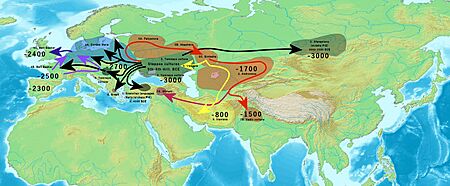
Studies of ancient DNA show that the Sintashta people were closely related to the Corded Ware culture. This suggests that the Sintashta culture might have come directly from an eastward movement of Corded Ware people. Both Sintashta and Corded Ware people had a lot of ancestry from Central Europe. This was different from the earlier Yamnaya Culture in the same area. People from the Bell Beaker culture, the Únětice culture, and ancient Scandinavian cultures were also genetically similar to the Corded Ware people.
One study looked at the DNA of many individuals from a Sintashta cemetery called Kamennyi Ambar-5. Most of these people (about 80%) were genetically similar to the Corded Ware culture and later cultures like the Srubnaya culture and Andronovo culture. These groups had mixed ancestry from the Yamnaya culture and people from Central Europe.
However, some Sintashta individuals had different types of ancestry. This suggests that the Kamennyi Ambar settlement was a diverse place, bringing together people from different genetic backgrounds into one social group.
Horse Genetics
The spread of a specific horse genetic line, called DOM2, is linked to the groups of people who lived before the Sintashta culture. This DOM2 line is believed to be the ancestor of all modern domesticated horses. A study from 2021 suggests that these horses were specially bred for traits like being calm, handling stress well, running long distances, and carrying heavy loads.
See also
- Sintashta
- Arkaim
- Petrovka settlement
- Country of Towns
- Multi-cordoned ware culture
- Cimmerians
- Karasuk culture
- Andronovo culture


